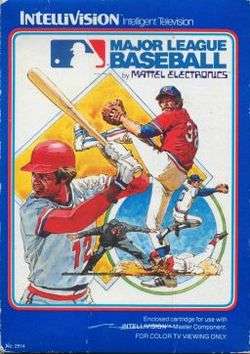Baseball (Intellivision video game)
| Baseball | |
|---|---|
 Intellivision cover art | |
| Developer(s) | Mattel |
| Publisher(s) | Mattel |
| Designer(s) | David Rolfe[1] |
| Platform(s) | Intellivision, Atari 2600 |
| Release |
|
| Genre(s) | Sports |
| Mode(s) | Multiplayer |
Baseball (released as Major League Baseball) is a multiplayer sports video game produced by Mattel and released for its Intellivision video game system in 1980. The best-selling title in the console's history, with over 1 million copies sold,[1] Baseball put players in control of a nine-man baseball team competing in a standard nine-inning game. When first released, Mattel obtained a license from Major League Baseball, although the only trademarked item used was the MLB logo on the game's box art. No official team names or player names were used in the game.
Gameplay
In Baseball, the player's team must score more runs than the opponent's team by the end of the game. The game consists of nine innings and takes place on a simplified baseball diamond.
Player 1 always plays as the visiting team and bats at the top of the innings, with Player 2 playing the home team and batting at the bottom of the innings. The pitching player selects a pitch to throw by pushing the controller in one of eight cardinal directions, each representing a different speed and direction for the pitch. The batting player then attempts to hit the ball into play and reach base safely, so that subsequent batters can also hit the ball into play and move the base-runners around to home plate and thus score a run. If the ball is hit into play, the pitching player uses the keypad on their controller to select the fielder to control and attempt to catch the ball, then selects the player to receive the throw, with the intent of putting the runner "out."
The batting player is able to advance the base-runners off base in an attempt to steal a base, but the pitching player can counter that with an attempt to pickoff the runners before the pitch is thrown.
If the score is tied at the end of the 9th inning, extra innings are played as necessary until a winner is determined.
Variations from standard baseball
Even though the two teams represented in Baseball were basically the same, the level of simulation was remarkable for its day, with a wide array of baseball strategy available to the players. Double plays, triple plays, rundowns and intentional walks are all possible within the game's context. However, a number of changes were made to the game. For example, all hits were automatically grounders, with no provisions for flyballs. Despite that change, home runs are still possible and depend on how and where the ball is hit.
Another major change allows the batting player to score a run on a third out, if the base-runner reaches home plate before the third out takes place.[2] For example, if the bases were loaded with two outs as the batter hits the ball into play, the runner on third base could score if a throw to third base forcing out the runner from second base (thus, the third out) arrived after the runner on third crossed home plate but before the runner from second base reached third base.
Ports
Sears sold the game without the MLB license for its private-label "Super Video Arcade," and Mattel's "M-Network" produced an Atari 2600 port called Super Challenge Baseball.[3] After Mattel Electronics ceased production of the Intellivision system and its assets were sold to INTV Corporation, Major League Baseball was re-released under the new name Big League Baseball.[1] More recently, the game appears in the Intellivision Lives compilation game and on Microsoft's Game Room service simply as Baseball.
Reception
Baseball was reviewed by Video magazine in its "Arcade Alley" column where it was praised for its inclusion of moveable fielders and "flashy" baserunning techniques like the suicide squeeze. Criticism was given to the somewhat simplistic pitching controls, and the fact that "all batted balls are grounders", but over all the game was described as "blow[ing] away" all other contemporary Baseball video games.[4]:12, 92 The game was also covered in Video magazine's 1982 Guide to Electronic Games where reviewers noted that the game "ha[d] lost none of its luster" since its release.[5]:53
References
- 1 2 3 "Major League Baseball". IntellivisionLives.com. Archived from the original on 2010-02-11. Retrieved 2010-06-10.
- ↑ "Major League Baseball instructions". IntellivisionLives.com. Retrieved 2010-06-10.
- ↑ "Super Challenge Baseball". GameFAQs.com. Retrieved 2010-06-10.
- ↑ Kunkel, Bill; Laney, Frank (August 1980). "Arcade Alley: Armchair Athletes - Sports, Mattel-Style". Video. Reese Communications: 12, 92, and 93. ISSN 0147-8907.
- ↑ Kunkel, Bill; Katz, Arnie (November 1982). "Video's Guide to Electronic Games". Video. Reese Communications. 6 (8): 47–56, 108. ISSN 0147-8907.